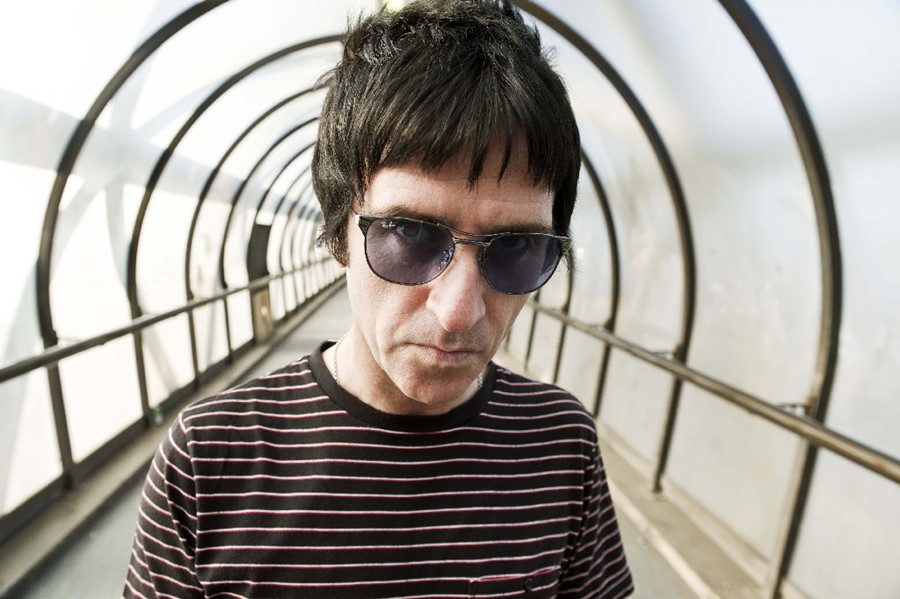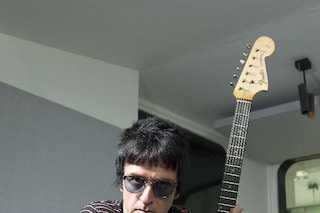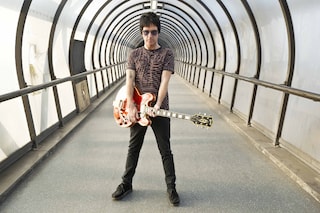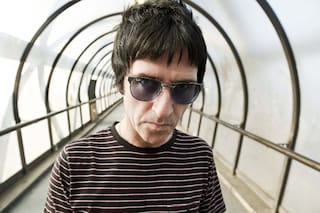In this exclusive interview, we speak to the iconic guitarist about his stints working with The Smiths to Talking Heads, and his work with the Raw Sounds project
Since the dawn of popular culture, music and style have complimented and affected each other in ways that have defined generations. One definitive brand that has been a constant symbol of style throughout the past five decades of music is Ray-Ban. From Johnny Cash to Bob Dylan, The Velvet Underground to The Smiths – and then on to pretty much every artist around – the omnipresent Ray-Ban sunglasses have adorned the face of all the musicians that have mattered.
One musician in particular, whose iconic sound has rippled throughout the musical fabric of the decades following his beginnings, is Johnny Marr. Perhaps the most influential guitarist of his generation, Marr is cited repeatedly as being the most important and significant inspiration to many – if not most – guitarists of the last 20 years. Ray-Ban Raw Sounds is a unique project that unites these two icons. Marr spearheads a creative and experimental concept in which five bands draw inspiration from five differing elements, chosen and/or created by Marr himself; and in conjunction, designing his own custom pair of Ray-Ban sunglasses.
Dazed Digital: You must be approached left, right and centre to join projects like this, what particularly attracted you to work with Ray-Ban?
Johnny Marr: At first it seemed like a mad request – they always do seem like mad requests these things. To begin with I was asked to do a concert it New York in Winter, and I thought ‘Ok, this kind of suits my plans for trying out some new material without it being about an album or tour etc’, so on a personal level it kind of suited me. But then my manager, who I’ve know since I was 17, was like ‘The first time I met you, you were wearing a pair of Ray-Bans, so it’s not that much of a farfetched connection’, plus I did some photographs with Mick Rock a few years ago for Ray-Ban... So I was open to the idea, but then they had this idea of me coming up with these ‘elements’. The idea at first, I thought was nuts and a really odd concept, but then I thought ‘Ok, this is an opportunity to do something really interesting that I wouldn’t ordinarily do’. Then when I met with them and asked what it was all about, they kind of just threw the ball back in my court, they said ‘You’re the artist, you come up with something’. It stuck in my mind for a few days; I was intrigued about the idea of presenting someone else with a jumping-off point in order to write a song or create something.
The challenge was to come up with five inspirational things that are relevant but not cliché – y’know a photograph of a Harley Davidson or a picture of Mick Jagger. It seems to me that rock and roll as a thing was already pretty cliché-ridden a long time ago, but there’s a new kind of rock and roll cliché that seems to have come up in the past ten years. It’s like the culture’s been hijacked somewhat – that kind of faux-LA/designer iconography. So straight away there was a little bit of a challenge, I was trying to present something that was of interest to me, but that could still inspire other musicians and also be part of this collaboration with Ray-Ban.
DD: The five elements are not just musical, they work across a range of mediums; do you think it’s important to work outside the realms of music in order for it to influence your output?
Johnny Marr: For me it’s almost imperative to work outside of music, but still within the arts. When you try and think of 5 things outside of music that could really influence a song, you first think that could be quite easy – but actually isn’t. It was important to me that I had things that I was genuinely interested in, otherwise it would just be fake, just be bullshit, and wouldn’t have any real feeling in it. So straight off I wrote this poem, a spoken-word piece called I Know The Radiant City. I got most of my ideas out of that one thing. I wanted to make sure there were some girls involved in what we were doing; I like Best Coast, they were the first thing that I thought of. I thought ‘OK, I’ll make this poem a spoken word piece by a girl’.
The short version of this answer is that first element that I came up with has got most of the things I’m interested in, and so I used that as a jumping off point. So I knew I wanted a poem that would be spoken by a girl, and to try and break the clichéd idea of cooperate rock and roll... I made a little movie called ‘strum and drang’ which is again a European reference. It seemed a little silly for me to collaborate with some musicians and not to have my guitar playing involved, but I wanted not to be obvious so I made a movie without my head on, it’s me playing this looped riff round and round that I tried to compose so any of the bands could maybe take a piece of it – they could slow it down or speed it up, chop it up or discard it, don’t even have to use it – but again I like the idea of not pretending that we live in a modern world, so if I’m asked to be a contemporary rock musician, I didn’t want it to be like, oh this sort of iconic guy from the 80s.
So I thought how can I present this music to the bands in a modern way – what’s the way I can offer a guitar part to a group without me walking in with my sunglasses on and plugging into an amp and saying ‘let’s jam!’. And that’s to put it on the Internet. So I thought, I’ll make a movie but without my head on it, so it’s just my arms and I’ll give each of the bands a link... I got a map of the Lower East-side because that has a pretty obvious connection with the rock and roll I like – the CBGBs kind of stuff - and I also like the idea of using a map because it’s less obvious than a painting, I’ve already got a German philosopher, I’ve already made a movie – it’d be a visual overload to then present someone with a painting. I thought I’d use something really old yet contemporary. It’s taken a few weeks to come up with all that stuff and execute it, but I’ve really enjoyed it.
DD: The bands that you pick will undoubtedly look back on this collaboration as a significant musical memory; what are yours?
Johnny Marr: I have loads; some of them are necessarily that old either. A big thing for any musician is inevitably the festival experience - festival culture seems to dominate the music industry and is almost a cultural phenomenon. A certain festival experience I’ll always remember is sitting on the drum riser for Frank Black’s band, that was really good - I didn’t even know he was playing - I love his solo stuff. The Cribs playing Glastonbury was pretty good fun, also playing Reading in 2008. I’ve got too many years of that sort of stuff, playing in the Albert Hall numerous times etc.
DD: You worked on the score for Inception, how does composition with cinema differ to the traditional band setup?
Johnny Marr: It’s a massive difference. First off, anybody who says they’re given 100% artistic freedom is lying, because the director always has the final say. You need to go into it knowing that and wanting to feel like you can do anything you want, but knowing that’s the bottom line. However, if you’ve got a good relationship with a director, then pretty much most of things you do, work.
A big difference to me is that you’re obviously led by an emotion on the screen; often when you use that word people interpret it as ‘emotional’ and ‘sad’, but there’s panic, anxiety, sexuality, tension… that really becomes quite evident when you have to bring that out using six strings and a piece of wood. And I really like that, one of the things that makes it easier, is that you know when it’s wrong. 'Inception' is very emotional, and I think that entire movie, for me the most powerful aspect that isn’t the clever dream stuff – as entertaining as that is – or the heist, it’s the fact that this person is on this constant emotional story. Leonardo DiCaprio is constantly churned up all the time, he’s going through exercises and is always going through this underlying turmoil. So when I was playing it, I had my eyes on that all the time, trying to keep it as emotional and deep as I could. Even if the audience didn’t know it, I’d watch it and know.
DD: Over the years you’ve appeared and recorded with a massive amount of artists – Pet Shop Boys, Modest Mouse, Girls Aloud, Tom Jones, The Cribs etc. How do you pick who you work with?
Johnny Marr: I make music with people I admire, or my friends, or in the case of Tom Jones and Girls Aloud – I kind of get tricked into it! When Beck asked me to work with him, I’m guessing that it’s going to be an interesting experience... Modest Mouse specifically invited me over to write some songs with them and join the band before we’d even met really, that because of what I’d done with Talking Heads, they didn’t really care about what I’d done with The Smiths really. I really liked Modest Mouse, that’s why I chose that. Pet Shop Boys were a band I admired and also something that wouldn’t be obvious for them or me...
DD: Is there anybody you’d like to work with that you haven’t yet?
Johnny Marr: I think I could do pretty well on a Polly Harvey track, I think I could do that. I really like the guitar on her records; that’s the thing, she’s already got good guitar playing on her records.
DD: There is a ridiculous amount of guitarists who cite you as one of their main influences; who were you influenced by?
Johnny Marr: I was influenced by records mostly, which is why I play the way I do. I liked 45s, 7” singles when I was growing up… luckily when I was a little kid, pop music was made by interesting musicians: David Bowie, Roxy Music, Sparks. It really was a good time for all that stuff. But actual guitar players, the guy who really knocked me for six was James Williamson who plays on the Raw Power record from Iggy & The Stooges... I got into it because I was playing a certain way and one of my friends said ‘that sounds like James Williamson’, so I thought I’d better hear this, and the intro of Gimme Danger sounded like the way I played at 15, so I made this connection with James and thought of him as quite a heroic character.
I also really liked the Patti Smith Group, and the folk guitar player Bert Jansch. When I was 15, 16, 17, all the music that was made for my age group was pretty naff unfortunately, it was the bad end of New-Wave, all these blokes pretending they were 10 years younger than they were, pretend punks... I was too young for punk, my generation was after that, it was interesting – you weren’t allowed to this, you weren’t allowed to do that… so many things that you were left with a very narrow criteria, which were luckily very tasteful. I’m aware of that because today, so much is available to us – which is obviously a great thing. The idea of being able to make music on something that is smaller than a book, pulling up organ sounds, electric synth, distorted guitars… all this choice, the young me would have been bananas for it. But with all this choice comes a risk of putting too many things in.
DD: Are you interested in getting involved in more projects and experiments like Ray-Ban Raw Sounds?
Johnny Marr: I’m interested in things that connect with music and are artistic but not necessarily the usual thing. I guess that’s the short answer to your first question! But that’s something that really interests me, if you’re fortunate enough to be given the opportunity to be creative, then you really are quite lucky. I’m not going to paint, or manage a band or anything, but it’s good as a musician to look at what you’re doing and wonder if there’s a more interesting way of doing it. As I get older I feel more and more artistic, what I’m best at creatively is playing guitar in a band and sometimes singing... It’s fun, but I really love work.
Photos by Pat Graham







